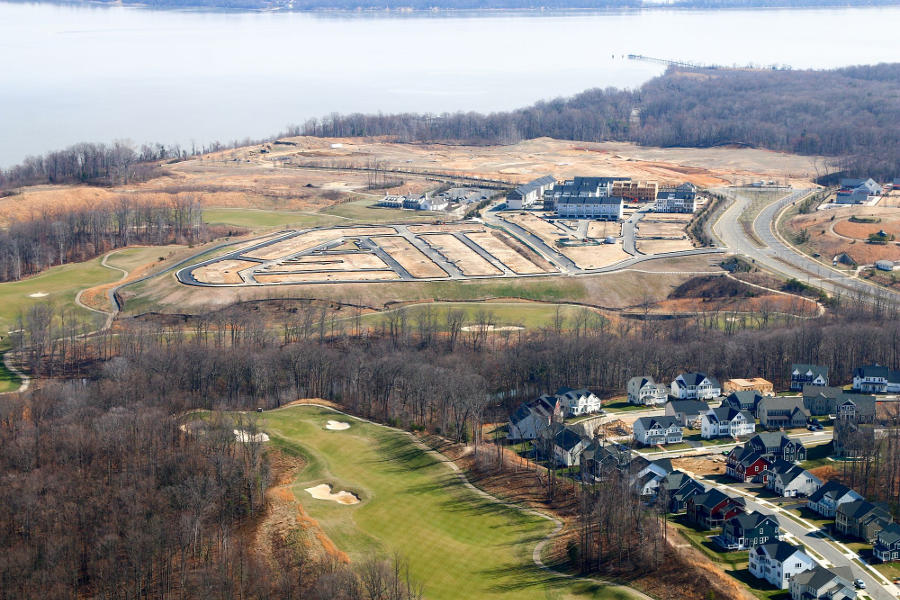
construction of Potomac Shores on Cherry Hill peninsula in 2018
Source: Historic Prince William, Potomac Shores - #137

construction of Potomac Shores on Cherry Hill peninsula in 2018
Source: Historic Prince William, Potomac Shores - #137
Cherry Hill Peninsula was not developed over the last 50 years, while the rest of eastern Prince William was covered with houses, because of topography and soils. The hillsides are steep, and the soils include a marine clay that shrinks and swells with moisture. The expansion/contraction will destroy structures unless expensive mitigating measures are used, such as laying foundations and pipes in a bed of sand, gravel, and imported soil.
Such soils are not uncommon in the area. The Virginia Department of Transportation (VDOT) failed to identify a patch of shrink-swell clay when it built the HOV lanes just north of the Occoquan River, and VDOT was forced to close several lanes and reroute traffic for several months while it built an expensive retaining wall that had not been considered necessary in the original plans. Drive into Leesylvania State Park nearby, and you can see a slope reinforced with heavy rocks to prevent another landslide in a stretch with unstable soils.
In 1993, Cherry Hill was a finalist as the site for a theme park, Legoland. The park was ultimately built in Carlsbad, California, in part because the climate there permitted year-round operation. The peninsula has also been proposed for locating another bridge across the Potomac River, connecting I-95 to US301 in Maryland. The subdivision at the base of the Cherry Hill bluffs was even named "Southbridge," though the likelihood of a bridge at that location remains remote due to opposition from Maryland.
Building on Cherry Hill will be expensive. Not surprisingly, the owner/developer, Legend Properties, wants the county to approve high-density development to offset the costs and maximize profits. The peninsula is not in the Rural Crescent, though the official zoning status is confusing and some county maps have avoided labelling the zoning density altogether.
In the summer of 2000, Legend proposed a $3 billion "Southbridge at Cherry Hill" development, with a town center, 3.8 million square feet of office/retail/industrial space, and over 3,000 new homes (counting the additional proposals for developing along the entrance road). The Washington Post in its September 2, 2000 article described the project as "massive."
Many Virginia counties just dream of such a development proposal, and have a hard time understanding why Northern Virginia counties appear to be anti-growth. The new town center is projected to become a vibrant community center. The increased economic activity from Southbridge at Cherry Hill should rejuvenate the area - and the Route 1 corridor in Prince William is already recognized as needing an economic stimulus. The county had proposed a highway along the Potomac River to stimulate development between Occoquan and Quantico. County voters rejected the proposed bonds to finance it; opponents had called it a "commuters road" to benefit developers rather than preserve the waterfront. Now, Legend has proposed developing Cherry Hill in the same style as the county had sought, without the road - and with a new Virginia Railway Express commuter station to transort workers downtown.
But there will be impacts on the public. The natural setting will be replaced, though the proposal does set aside 40% of the acreage for forest habitat. The wildlife in the other 60% will be displaced or, in most cases, eliminated by the development. In addition, two bald eagle nests on Cherry Hill Peninsula may be disturbed - and certainly erosion from the hillsides could impact the Potomac River and the Chesapeake Bay watershed. The workers who travel to Tysons Corner or Dulles will add to the congestion on the highways. To some, a massive development on Cherry Hill is a grossly-inappropriate development, since over 75% of Cherry Hill is a combination of highly erodible soils and 15% or greater slopes.
In early 2000, the battle lines over Cherry Hill began to emerge. The State Department of Forestry suggested the peninsula should be preserved in its natural state, and others described the hilly environment as too sensitive to develop under any realistic condition. In one scenario, Legend is not serious about investing $3 billion in a speculative development. By that scenario, Legend will seek to obtain county approval for a massive development - and then sell the land to the government at a high price, without ever developing it. Such "greenmail" is not uncommon in wilderness areas in the western United States, and the State of Maryland has purchased large waterfront parcels such as Chapman's Landing across the Potomac River to stop development and preserve the natural setting. Such an approach would require Legend to obtain county approval while generating national concern, and timing the two so any threat of condemnation would occur only after the development proposal was approved as the "highest and best use" of Cherry Hill.
The peninsula is a rare example of a large block of Northern Virginia land in one ownership being proposed for development at one time. It provides the county an opportunity to incorporate permit requirements for environmental protection and social objectives, without overly burdening the landowner's potential for profitable development. It also provides the "smart growth" advocates with a target, as well as an opportunity. The evolution of Cherry Hill will provide yet another reason to keep an eye on Prince William County land use...